Staff augmentation adds external talent to your team temporarily, providing flexibility and specialized skills. Outsourcing involves handing over entire projects or functions to third parties, aiming for cost savings and efficiency. The decision between them hinges on your project requirements and business goals, sparking curiosity about the best fit for your organization.
But what exactly distinguishes these two models, and which one is suited for your business operations? Well, don’t worry – we’re here to guide you.
In this blog, we will discover:
- Different business scenarios particularly suited for both approaches.
- The major differences between staff augmentation vs. outsourcing.
- Risks and challenges associated with each strategy and mitigation tips.
- Case studies demonstrating the successful application of each model.
A Quick Overview of Staff Augmentation
Staff augmentation is a strategic workforce solution that involves hiring temporary or contract professionals to augment an organization’s in-house team. This approach often addresses specific skill gaps, manages workload fluctuations, or tackles short-term projects.
Pros of staff augmentation
According to a report, global spending on staff augmentation will reach around US$81.87 billion by 2025. Here’s why the staff augmentation services are gaining widespread appeal:
- Flexibility: Staff augmentation provides the flexibility to scale your workforce up or down as needed. You can quickly adapt to changing project demands without the long-term commitment associated with hiring full-time employees.
- Cost-Effective: It can be a cost-effective solution compared to maintaining a large existing team. Companies can save on benefits, training, and infrastructure costs.
- Specialized Skills: Access to specialized skills and expertise that may not be available in-house. This allows organizations to take on complex projects without extensive training.
- Speed: Rapid recruitment and onboarding of temporary staff, reducing the time-to-market for projects.
Cons of staff augmentation
Along with those brilliant benefits, this strategy also boasts some disadvantages, including:
- Management Overhead: Managing a mix of in-house and augmented staff requires effective coordination and management to ensure seamless collaboration.
- Privacy Issues: There may be security concerns related to sharing sensitive company data with external personnel.
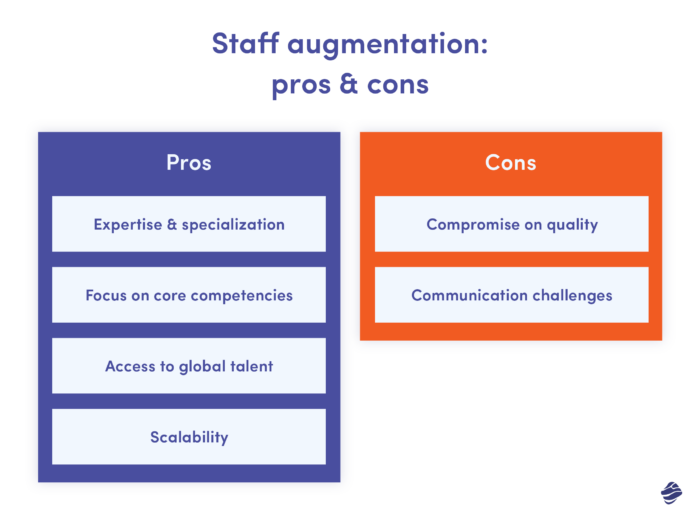
A Quick Overview of Project Outsourcing
Software project outsourcing is a business strategy in which an organization contracts out specific functions or processes to third-party service providers. This approach involves transferring the responsibility of certain tasks or services to external experts or companies.
Pros of project outsourcing
Do you know that global spending on outsourcing is expected to reach US$1.1 trillion by 2025? Wondering why? Well, here are some compelling reasons:
- Expertise & Specialization: Outsourcing firms are often specialists in their respective fields. When you outsource a specific function, you gain access to experts who have honed their skills and knowledge in that area.
- Focus on Core Competencies: It allows organizations to focus on their core business functions while delegating non-core activities to specialists. This can lead to increased efficiency and competitiveness.
- Access to Global Talent: Outsourcing can provide access to a global talent pool, allowing companies to tap into specialized skills and expertise that may not be available locally.
- Scalability: Outsourcing partners can often scale their resources up or down quickly, aligning with your business needs.
Cons of project outsourcing
Of course, outsourcing also has a fair share of disadvantages, such as:
- Compromise on Quality: When outsourcing, companies relinquish some level of control over the processes being outsourced. This can be a concern if quality standards and security are paramount.
- Communication Challenges: Managing remote teams and different time zones can present communication challenges, potentially leading to delays and misunderstandings.
Staff Augmentation vs Outsourcing – The Major Differences
Staff augmentation and outsourcing are two distinct strategies businesses use to address their needs for additional skills or resources. Understanding the differences between these approaches is crucial for making informed decisions that align with an organization’s goals and operational dynamics.
That said, let’s explore the differences between these two strategies:
Cost Implications
- Staff Augmentation: In this model, the cost is typically associated with the salary of the augmented staff plus a markup from the staffing agency. This model can be cost-effective for short-term projects, as it avoids the long-term costs associated with hiring a dedicated team of full-time employees, such as benefits, training, and equipment.
- Outsourcing: Contrarily, this strategy can lead to significant cost savings, especially when tasks are outsourced to companies whose labor costs are lower. However, the total cost must also account for the management of coordinated efforts, potential quality control issues, and other risks associated with relying on an external provider.
Control and Management
- Staff Augmentation: With this model in action, you can maintain full control over your projects and the augmented staff as they work within your existing operational structures and management. This approach ensures that you can directly manage the work quality and project direction, aligning closely with your business culture and processes.
- Outsourcing: In an outsourcing arrangement, the external service provider assumes responsibility for managing the outsourced function or project. This can reduce your control over day-to-day operations and potentially lead to differences in work culture and priorities.
Flexibility and Scalability
- Staff Augmentation: By implementing this strategy, you can easily adjust the number of augmented staff members based on your project’s needs, scaling up or down as required. This adaptability allows you to respond swiftly to changing market conditions.
- Outsourcing: Meanwhile, outsourcing may have limitations in terms of flexibility. Contracts and service agreements often come with fixed terms and conditions, making it more challenging to make immediate adjustments. Scalability may require renegotiating contracts or engaging with additional service providers.
Quality and Expertise
- Staff Augmentation: Augmented staff are often highly specialized professionals who can bring in-depth expertise and innovation to your specific project. This can enhance the quality of work and drive better outcomes as long as their skills are effectively integrated with your team’s efforts.
- Outsourcing: The outsourced team is typically specialists in their respective domains, offering a high level of expertise. However, aligning their work quality with your standards might require clear specifications, regular communication, and effective oversight.
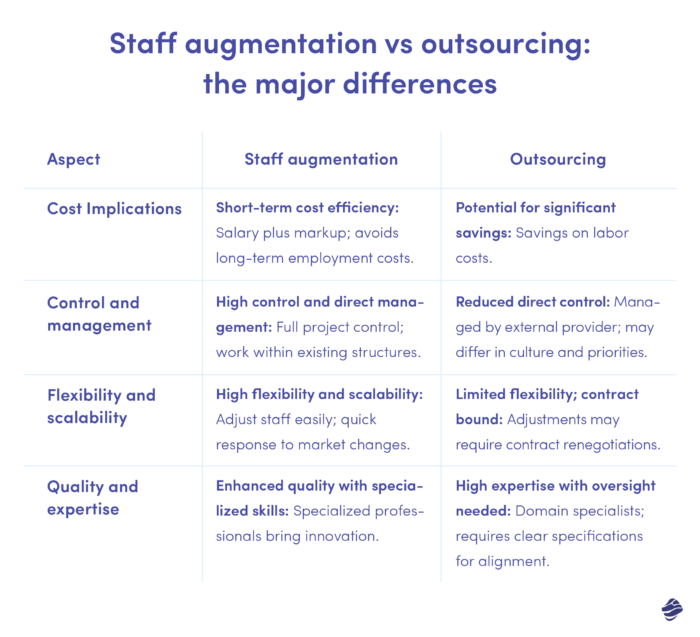
Challenges Associated With Staff Augmentation
Staff augmentation comes with its own set of challenges and risks. Addressing these effectively ensures that the augmentation serves its intended purpose without causing disruptions. Here are some common challenges associated with the staff augmentation service provider and strategies to mitigate them:
1. Cultural and Communication Barriers
- Challenge: New staff may have difficulty integrating into your company’s culture, leading to communication issues and a lack of cohesion within teams.
- Mitigation: Promote a culture of inclusivity and provide comprehensive onboarding that emphasizes your company’s values, communication styles, and expectations. Regular team-building activities and meetings can also help in bridging cultural gaps.
2. Knowledge Transfer and Training
- Challenge: Temporary staff may require significant time and resources to come up to speed with projects, which can delay progress.
- Mitigation: Develop structured training programs and maintain thorough documentation of projects and processes. Assign mentors or buddies from your existing staff to facilitate quicker knowledge transfer and integration.
3. Quality Control
- Challenge: There may be variations in the quality of work produced by augmented staff, especially if they are not accustomed to your standards or methodologies.
- Mitigation: Implement regular check-ins and reviews to monitor the quality of work. Establish clear, measurable standards for performance and provide feedback and guidance as needed.
4. Security and Confidentiality Concerns
- Challenge: Introducing external personnel can expose your organization to increased security risks and potential breaches of confidentiality.
- Mitigation: Ensure all augmented staff, including the project manager, sign non-disclosure agreements and undergo training on your company’s security policies. Limit access to sensitive information and systems to only what is necessary for their role.
5. Dependency and Sustainability
- Challenge: Over-reliance on augmented staff can make your organization vulnerable to their availability and hinder internal capability development.
- Mitigation: Use staff augmentation as a strategic tool rather than a long-term solution. Focus on developing internal skills and capabilities and use augmentation for specialized skills or temporary capacity boosts.
Pro Tip: Utilize performance metrics and key performance indicators (KPIs) to objectively assess the effectiveness of augmented staff.
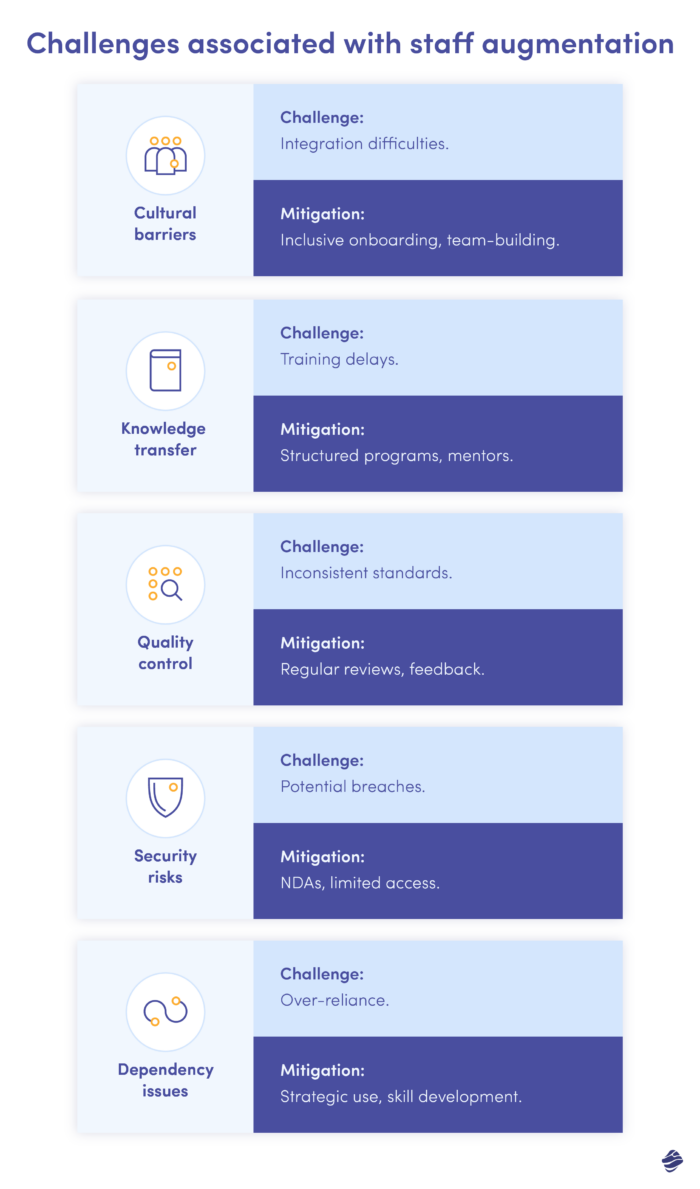
Challenges Associated With Outsourcing
Outsourcing comes with its own set of challenges and risks that need to be managed effectively:
1. Loss of Control
- Challenge: Outsourcing certain tasks or projects can lead to reduced control over those functions, potentially affecting quality, adherence to deadlines, and alignment with company standards and objectives.
- Mitigation: Establish clear, detailed contracts and service level agreements (SLAs) that specify the quality standards, timelines, and deliverables. Regularly monitor performance against these benchmarks and maintain open lines of communication with the outsourcing partner.
2. Communication Barriers
- Challenge: When outsourcing, differences in language, time zones, and cultural nuances can hinder clear and effective communication, leading to misunderstandings and delays.
- Mitigation: Utilize technology such as video conferencing and collaborative online tools to facilitate clearer communication. Establish a communication protocol that defines the frequency, tools, and formats of updates and meetings. Providing cultural and language training to project managers and other employees can also help bridge communication gaps.
3. Hidden Costs
- Challenge: The perceived savings from outsourcing can sometimes be offset by unexpected expenses such as legal fees, transition costs, and management overhead, making the process more costly than anticipated.
- Mitigation: Conduct a thorough cost-benefit analysis before committing to outsourcing, including all potential hidden costs. Regularly review and manage the outsourcing relationship to ensure it remains cost-effective.
4. Quality Issues
- Challenge: Outsourced services might not always meet the expected quality standards, affecting the company’s product or service delivery and customer satisfaction.
- Mitigation: Define and enforce strict quality control procedures and standards with the outsourcing partner. Regular quality assessments and feedback loops can help maintain the desired level of quality.
5. Security Risks
- Challenge: Outsourcing can expose an organization to increased risks in terms of data security and intellectual property protection, especially when sensitive information is involved.
- Mitigation: Conduct due diligence to ensure the outsourcing partner has robust security protocols in place. Include stringent data protection and privacy clauses in the contract, and consider regular security audits to ensure compliance.
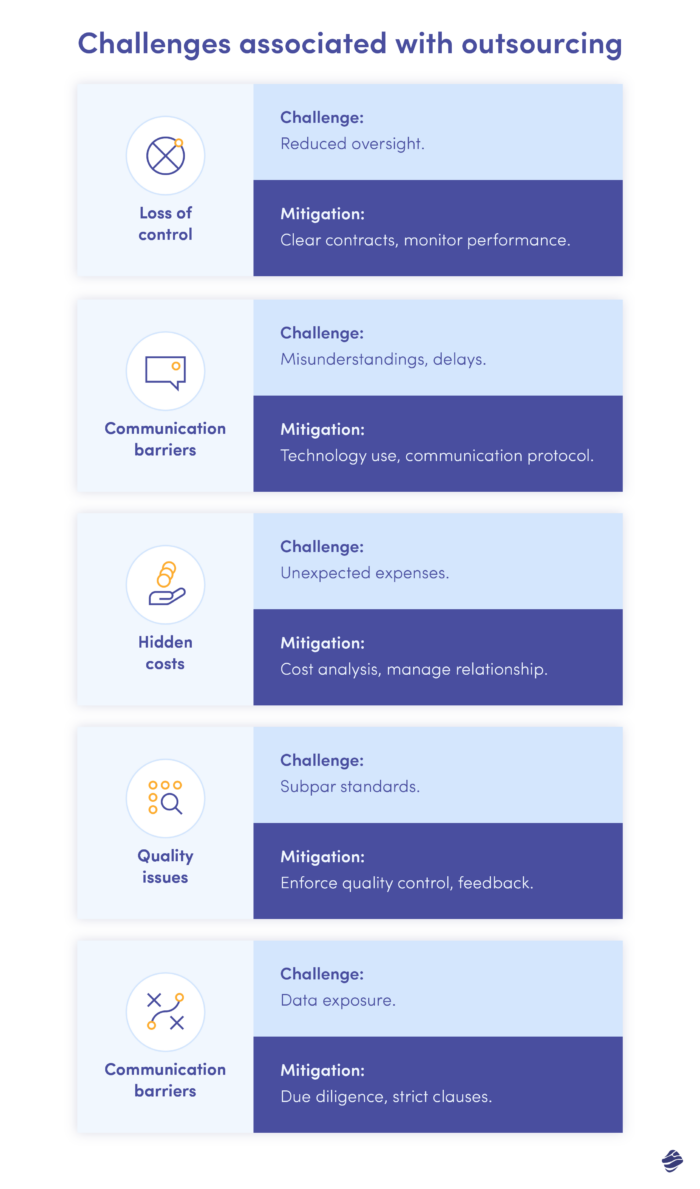
Which One’s Best For Me? (Business Scenarios for Each Model)
Choosing between staff augmentation and project outsourcing is a critical decision that businesses often face when seeking to address their resource needs. Each model offers unique advantages and is better suited to specific business scenarios.
Let’s explore when to opt for staff augmentation and when project outsourcing makes more sense:
When to Choose Staff Augmentation
- Flexibility and Scalability: Staff augmentation is an ideal choice when your business needs to rapidly scale up or down its workforce. Whether you require additional expertise temporarily or for an extended period, staff augmentation allows you to flexibly adjust your team size according to your project requirements.
- Short-Term Skill Gaps: If your team is temporarily lacking specific skills or expertise required for a particular project, staff augmentation allows you to quickly fill those gaps. This can help ensure project success without the need for long-term hiring commitments.
- In-House Control: When you want to maintain direct control over your projects and retain them in-house, staff augmentation is a favorable option. You can seamlessly integrate augmented staff into your existing team, maintaining your company culture and management style.
- Cost-Efficiency: Staff augmentation can be cost-effective for short-term or sporadic resource needs. You only pay for the additional expertise or workforce when needed, eliminating the costs associated with hiring, training, and maintaining full-time employees.
- Project-Based Work: Staff augmentation is often chosen for projects with evolving requirements, where the workload fluctuates over time. It provides the adaptability required to meet changing project demands.
When to Choose Project Outsourcing
- Well-Defined Projects: Project outsourcing is suitable when you have clearly defined project requirements and a well-documented scope of work. This model is particularly effective for fixed-price projects with a set timeline and deliverables.
- Cost Predictability: Outsourcing provides cost predictability since you agree on the project’s budget and timeline upfront. This can be advantageous when managing your project budget carefully without unexpected cost overruns.
- Specialized Expertise: If your project requires highly specialized skills or technologies that are not readily available in-house, outsourcing allows you to tap into a vendor’s expertise. This ensures that your project benefits from the best industry practices and cutting-edge knowledge.
- Focus on Core Competencies: Project outsourcing allows your organization to focus on its core competencies while leaving non-core activities to specialized vendors. This can improve efficiency and overall business performance.
- Reduced Management Overhead: With project outsourcing, you delegate project management responsibilities to the vendor, reducing your own management overhead. This is particularly valuable when you want to concentrate on strategic aspects of your business.
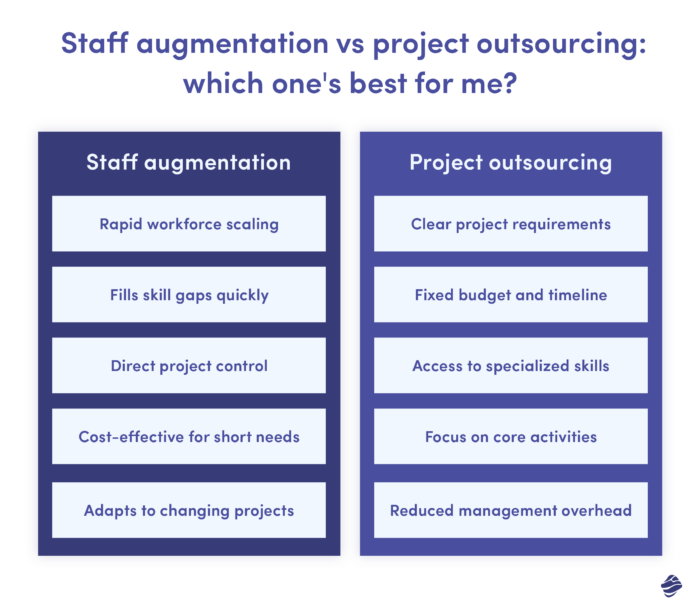
Real-World Examples of Projects Involving Staff Augmentation Services
Here are a few real-world examples showcasing the success of both staff augmentation and outsourcing:
1. Nextbank – A Miquido Project
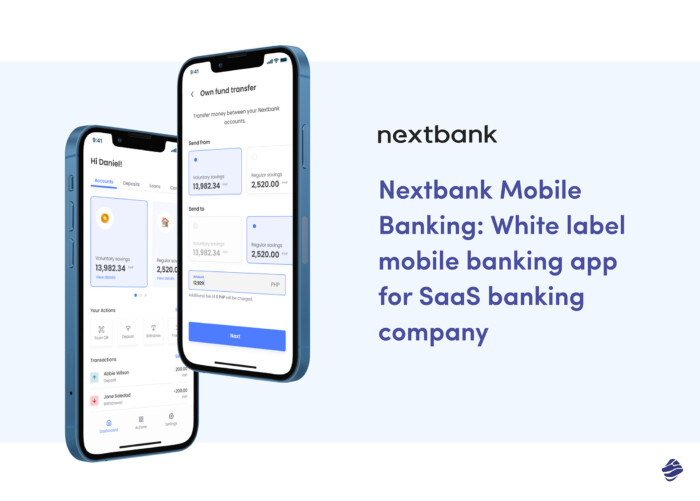
Nextbank delivers cloud banking services across Southeast Asia, offering customizable banking applications within 10 weeks. They utilized Miquido’s staff augmentation service to develop an accessible, secure, and easily maintainable Android mobile banking application.
Challenge:
The primary challenge was integrating with local payment, KYC, remittance, and insurance providers in Asia, requiring a secure and compliant microservices architecture. Additionally, there was a need to comply with OWASP security standards and create a universally accessible and customizable mobile banking app.
Miquido Approach:
Here’s how Miquido managed services:
- Emphasized third-party integrations for local payment and financial services.
- Recommended rewriting the app using Flutter for enhanced security and maintainability.
- Focused on a minimalist and functional design for the white label app to ensure user-friendliness and scalability.
Results:
The results were as follows:
- Successfully integrated with local service providers while balancing security and performance.
- Developed a feature-rich, cross-platform mobile banking app that prioritizes data protection and user experience.
- Delivered a competitive, easily customizable mobile banking app that supports diverse user requirements and devices.
Inspired by Miquido software development success? Want to create your own software? If so, then you may read how to start a software project.
2. MERCK

Merck & Co., a prominent global pharmaceutical firm, has strategically employed staff augmentation contracts to bolster its extensive capital projects program, which encompasses several countries and thousands of projects.
The company has leveraged a variety of staffing positions, such as contract administrators, quality control inspectors, purchasing analysts, and construction auditors, among others. This approach has granted Merck notable flexibility, ensuring optimal placement of resources exactly when and where needed.
The result has been a significant enhancement in maintaining its core business momentum while achieving substantial cost savings through adept staff scaling.
3. The University of Texas Medical Branch (UTMB) in Galveston, TX
UTMB utilized a staff augmentation contract for recovery projects following damage caused by Hurricane Ike and subsequent storms. With over 90 buildings needing repair and mitigation services, the staff augmentation approach allowed UTMB to implement projects concurrently, reducing the recovery schedule significantly.
4. The New York City School Construction Authority (NYCSCA)
For over 15 years, Hill has been supporting NYCSCA with expert scheduling, estimating, construction management, inspection, and other professional services. The NYCSCA, which oversees approximately 1,200 public schools, hired Hill to serve as an extension of staff services to their project management group, facilitating the construction of 200 new schools and renovations to existing ones.
Real-World Examples of Projects Involving IT Outsourcing Services
In this section, we’re going to explore some of Miquido’s most successful outsourcing projects partnering with of the world’s biggest companies and outline why it has worked so well.
Ready? Let’s go.
1. The HelloFresh App

HelloFresh, a leading meal delivery service, leverages technology to bridge the gap between chef-curated meals and the convenience of home delivery. By focusing on wholesome, easily prepared recipes, HelloFresh aims to transform the home cooking experience.
In their journey towards digitalization, they partnered with Miquido, an expert in mobile app development, to enhance their service delivery through a mobile app.
Challenge
The primary challenge faced by HelloFresh was to digitalize the fresh food shopping experience in a way that emphasized ease, efficiency, and dietary customization. This transformation required innovative technology solutions to meet the growing demand for convenient meal delivery while providing a user-friendly interface.
Miquido Approach:
To address this challenge, HelloFresh chose to outsource its mobile app development to Miquido. Miquido approach to project development solutions includes:
- The app was designed with the user in mind, ensuring that ordering meals was intuitive and straightforward.
- Miquido introduced a variety of meal plans within the app, providing customers the flexibility to tailor their dining experience to their preferences.
- Beyond the mobile app development process, Miquido also assisted in launching the HelloFresh Blog, an educational platform for customers interested in healthy eating and culinary inspiration.
Results:
The outsourcing partnership between HelloFresh and Miquido yielded remarkable results:
- The app achieved 1 million daily active users, reflecting its user-friendly design and appeal.
- HelloFresh’s valuation soared to €2.6 billion, underscoring the project’s financial success.
- The company was recognized as the No. 1 meal-kit company globally, a testament to its market impact and the effectiveness of its outsourcing strategy.
P.S., If you also want to create such an app, then it’s worth reading how to avoid mobile app development mistakes.
2. Skyscanner Car Rental – Another Outsourcing Success with Miquido
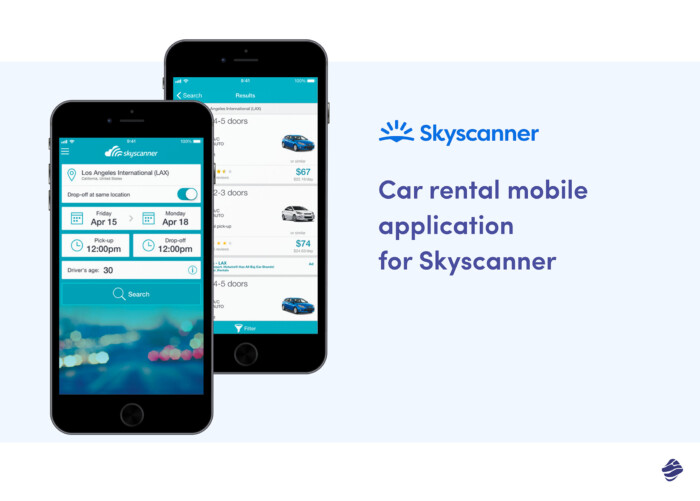
Skyscanner, a leading figure in the global travel industry, sought to redefine travel planning with its comprehensive mobile applications. To elevate the mobile experience for its Car Rental service, Skyscanner outsourced the development to Miquido, a strategic move aimed at harnessing external expertise to innovate and expand its mobile offerings to over 100 million users.
Challenge:
Skyscanner faced the challenge of rejuvenating its Car Rental mobile app, which was marred by outdated technologies, subpar user interfaces, and limited functionality. This affected the app’s performance, user satisfaction, and conversion rates, necessitating a sophisticated overhaul to stay ahead in the competitive travel market.
Miquido’s Outsourced Solution:
In addressing these challenges, Miquido’s outsourced approach focused on:
- Technology Overhaul: Adopting Java for Android and Objective-C for iOS, Miquido updated the app with the latest frameworks and tools to enhance functionality and user experience.
- Mapping and Integration: By incorporating Google Maps API for Android and the MapKit framework for iOS, the app offered an improved mapping experience, enabling effortless discovery and booking of rental services.
- User Engagement: Introducing user-centric search, comparison, and booking features significantly increased the app’s appeal and usability, ensuring a competitive edge in the market.
Outsourcing Results:
The outsourcing partnership yielded significant achievements:
- Revolutionized User Experience: The revitalized Skyscanner Car Rental app now delivers a seamless, intuitive booking process, vastly improving user engagement and satisfaction.
- Boost in Engagement and Conversion: The enhancements led to an influx of over 1 million new users, contributing to a substantial expansion of Skyscanner’s mobile presence.
- Strengthened Market Position: This successful outsourcing project has bolstered Skyscanner’s status as a travel industry pioneer, offering a superior, user-friendly car rental booking experience.
By choosing to outsource the development of its Car Rental app to Miquido, Skyscanner not only addressed critical challenges but also strategically enhanced its service offering, demonstrating the power of leveraging external expertise for technological advancement and market leadership.
Want to Hire A-players For Your Next Project?
When choosing between staff augmentation and outsourcing, the decision hinges on a business’s specific needs and strategic goals. Ultimately, both strategies can be part of a comprehensive approach to resource management, allowing businesses to adapt to changing market demands, technological advancements, and internal capabilities.
Key Takeaways:
- Staff augmentation allows for flexibility and control over your external team.
- Outsourcing offers a hands-off approach to the entire project completion.
- Consider your project size, complexity, and desired involvement when deciding.
If your business is navigating the complexities of team augmentation services and outsourcing, Miquido is Europe’s leading software development company with a proven track record of results to help you build out your ideas.
Simply get in touch with project details for a quote, and we’ll go from there.







